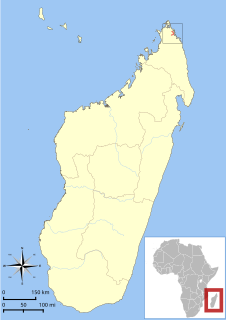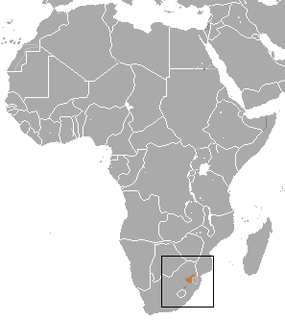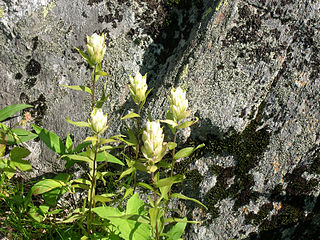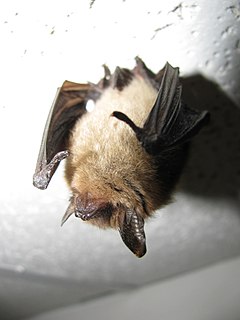
Homonota is a genus of South American geckos, commonly known as marked geckos.

The Cuban tree frog is a large species of tree frog that is native to Cuba, the Bahamas, and the Cayman Islands; but has become invasive in several other places around the Americas. Its wide diet and ability to thrive in urban areas has made it a highly invasive species with established colonies in places such as Florida, the Hawaiian island of Oahu, and the Caribbean Islands. These tree frogs can vary in size from 2 to 5.5 inches in length. Due to their large size, Cuban tree frogs can eat a wide variety of things, particularly native tree frogs, and their removal has shown to result in an increase in the amount of native tree frogs in an area. The tadpoles of Cuban tree frogs also heavily compete with native frog tadpoles, which can cause negative effects in body mass, size at metamorphosis, and growth rates for the native tadpoles.
Jainosaurus is a genus of titanosaurian sauropod dinosaur of India and wider Asia, which lived in the Maastrichtian. A herbivorous quadruped, an adult Jainosaurus would have measured around eighteen metres long and held its head six metres high. No accurate estimate of the weight has yet been made. The humerus of the type specimen is 134 centimetres long.

The northern sportive lemur, also known as the Sahafary sportive lemur or northern weasel lemur, is a species of lemur in the family Lepilemuridae. It is endemic to Madagascar. As a result of severe ecological and human pressures, the lemur is classified as Critically Endangered (CR) by the IUCN Red List.

The highveld golden mole is a species of mammal in the golden mole family, Chrysochloridae. It is found in South Africa and Eswatini. Its natural habitats are temperate forests, subtropical or tropical dry forest, subtropical or tropical moist lowland forest, subtropical or tropical moist montane forest, moist savanna, temperate shrubland, temperate grassland, subtropical or tropical dry lowland grassland, arable land, pastureland, plantations, rural gardens, urban areas, and introduced vegetation. It is threatened by habitat loss.

Castilleja septentrionalis is a species of Indian paintbrush known by several different common names, including pale painted cup, northern painted cup, pale Indian paintbrush, and Labrador Indian paintbrush. The scientific name "Castilleja pallida (L.) Spreng. var. septentrionalis (Lindl.) Gray" has also been used in the past to describe this species.

Myotis septentrionalis, known as the northern long-eared bat or northern myotis, is a species of bat native to North America. There are no recognized subspecies. The northern long-eared bat is about 3–3.7 inches in length, with a wingspan of 9–10 inches. It is distinguishable by its long ears when comparing it to other bats in its genus. This species is commonly found in the northern United States and Southern Canada east of British Columbia. The geographic range includes 37 states.

Morchella septentrionalis species of fungus in the family Morchellaceae native North America. Described as new to science in 2012, it has a northerly eastern North American distribution, where it occurs north of 44°N. The fungus fruits under hardwoods, particularly American aspen and American ash.

The Chilean marked gecko is a species of gecko endemic to the Chilean matorral ecoregion, found chiefly in the nation of Chile. The common name for this species is Chilean marked gecko.

Homonota fasciata, also known as the South American marked gecko, is a nocturnal species of gecko. It lives in Bolivia, and in Argentina. It is found in tropical deciduous forest and desert scrub habitats. It feeds on insects.
Cei's marked gecko is a species of gecko. It is endemic to Argentina.

Borelli's marked gecko is a species of gecko. It lives in Argentina and Paraguay.

Homonota darwinii, also known as Darwin's marked gecko or prickly gecko, is a species of gecko. It is endemic to Argentina.

Homonota horrida, also known as South American marked gecko, is a species of gecko. It lives in Argentina and Paraguay.
There are two species of gecko named South American marked gecko:
Homonota rupicola is a species of gecko. It is endemic to Paraguay.
Homonota taragui is a species of gecko. It is endemic to Argentina.
Homonota underwoodi is a species of gecko, a lizard in the family Phyllodactylidae. The species is endemic to Argentina.
The Argentine marked gecko is a species of lizard in the family Phyllodactylidae. The species is endemic to Argentina.
Homonota williamsii is a species of gecko. It is endemic to Argentina.









